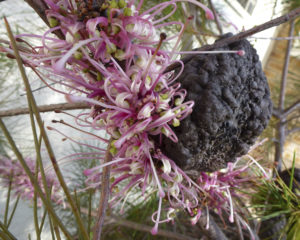APS NSW receives many email inquiries about native plants. Glenda Browne summarises recent questions and answers on flowering and plant selection from our experts group.
Acacia flowering history
A correspondent from the Central West was looking for an Acacia flowering history to help determine whether the current flowering months of Acacias were normal or a result of climate change.
We replied that there are some Acacias flowering for twelve months of the year, but that flowering time of individual trees and shrubs can be a puzzle. Some help is available from reference works:
- Acacias of Southeast Australia by Terry Tame
- Forestry Commission of New South Wales booklet called Trees and Shrubs for Eastern Australia which includes months of flowering amongst other growing information
- A Field Guide to Eucalypts (of South Eastern Australia) Volume one which includes months of flowering.
The APS Sutherland Group developed a CD about plants in the Royal National Park in Sydney. It has information on about 300 species including Acacias and gives a date range for flowering for each species. There is an online version at http://sutherland.austplants.com.au/webdemosearch.php. A user of the resource has noticed over recent years that flowering months seem to be changing for many of the plants.
Acacia baileyana purpurea not flowering
Someone else asked about their Acacia baileyana purpurea which was not flowering. The recommendation was to add some nitrogenous fertiliser. Even though wattles absorb nitrogen from the atmosphere it can sometimes help to add a bit of potash to help them along.
Hakea bakeriana not flowering
We gave similar advice to someone who saw our Hakea bakeriana on Instagram and said theirs had been growing (from seed) for 15 years and had never flowered. They had pruned several times, leaving the old wood from where it flowers, but still no luck.
One answer was that ‘It seems to me that sometimes a plant just does not wish to flower!’ Among the reasons for non-flowering are inadequate light, inadequate drainage, wrong soil for that species, and not enough fertiliser. Fertiliser/potash could be applied, remembering not to add phosphorus to this member of the family Proteaceae.
This plant grows naturally on the exposed coastal heathlands on the central coast, so likes full sun and gets wind pruned. Some in the Ku-ring-gai Wildflower Garden at St Ives in northern Sydney in a more sheltered position were observed to be somewhat shyer to flower and a bit more leggy.

Plant selection: hedges
A gardener had to replace a hedge. Murraya had been suggested, but she preferred to use bottlebrushes (Callistemons). She had lilli pillies elsewhere, but they had been ravaged by white scale / bugs and so she didn’t want to use them.
The group approved the choice and mentioned Callistemon citrinus and narrow-leaved bottlebrush (C. linearis) as options, along with some paperbarks (melaleucas) and tea-trees like Leptospermum petersoni.
We also advised that it is best to mix species to minimise the risk of disease.
Plant selection: root depth
One correspondent saw a corroboree bush (Spyridium scortechini) on ‘Gardening Australia’ and wondered how deep the root system was, as she planned to plant it in a bed that had water and sewerage pipes underneath.
Corroboree bush grows to about a metre. In general, root systems for shrubs follow a similar pattern to the green shrub above ground, therefore its roots are likely to only extend a metre below ground, which was within this person’s available area.
Plant selection: cold Central West
A gardener in the Central West was wondering what perennials they could plant. At that time they were experiencing frosty mornings of -3.5 C.
The Central West District Group section on the APS website has lists of plants suitable for Bathurst, Mudgee, Oberon, Orange and Wellington, as well as names of some local nurseries.
Specific recommendations of trees and shrubs from our group were snow gum (Eucalyptus paucifolia), Cootamundra Wattle (Acacia baileyana), red-stem wattle (Acacia rubida), Grevillea rosmarinifolia and weeping bottlebrush (Callistemon viminalis). Other suggestions were Xerochrysum (paper daisies), Chrysocephalum apiculatum, tussock grasses like Poa sieberiana and the local forms of Hardenbergia violacea.
The best time to plant was advised to be from March to April or September.
Sourcing seeds
Thank you to the member who emailed to let me know that APS NSW members can now request seeds from the APS Victoria seedbank. Details are at https://resources.austplants.com.au/stories/aps-vic-seedbank-available-to-nsw-members/
Article and photo permissions
Our articles and photos are popular. We quite often get requests to share articles (eg, one on banksias for social learning) and to use our photos. Permission is granted in most cases for non-commercial uses, with proper attribution. Recently our photos have been included in a paper on moth species distribution, and in a brochure on bush fruits for Hawaiian farmers.
We also had a request from a photographer for a garden containing billy buttons (Pycnosorus globosus), as he had photos of the flowers, but needed some of the leaves.
Thanks to John Aitken, Mark Abell, Rod Bray, Ralph Cartwright, Rhonda Daniels, Alix Goodwin, Heather Miles, John Nevin, Merle Thompson, Dick Turner
